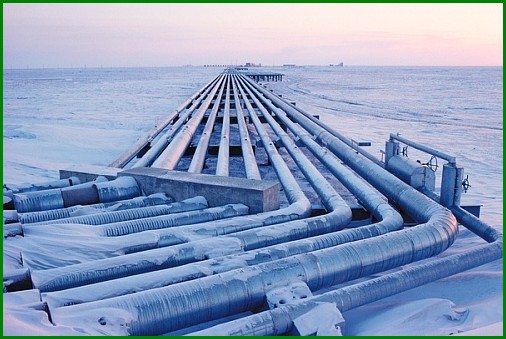Arctic warming will affect the climate of the entire planet Much has been written about how the Arctic warming will affect sea ice, polar bears and a growing human population, but it will affect the climate of the entire planet.
If the debate over this issue and there is, in most sluchaevschitaetsya that opening the region to shipping promises great benefits. It is estimated that the Arctic is located up to 30% of the world's undiscovered gas and 13% of oil reserves. In addition, the new routes will be built, which will lead to a revival of local trade. Insurance market Lloyd's of Londonepredskazyvaet that in the next ten years, investment in the Arctic could reach $ 100 billion

Gas pipes Endicott artificial island off the coast of Alaska (photo BC Alexander / Arctic Photo).
Some, however, recognize the high cost of environmental damage - for example, the same or Lloyd French oil giant Total. Danger of Arctic oil spill - the subject matter of the special committee of the National Research Council of the United States. But the overall cost estimate changes in the Arctic have not done.
And in general, the economic modeling of the impact of global warming is conducted is extremely rare.
Gail Whiteman from Rotterdam University. Erasmus (Netherlands) and takzheKris Hope and Peter Uedems from Cambridge University (UK) believe that the melting of the Arctic will fly us all a lot of money, as the region is crucial to the operation of such systems of the Earth, as the oceans and climate. Just the release of methane from thawing permafrost under the East Siberian Sea is priced at $ 60 trillion in the absence of countermeasures, which is comparable to the size of the world economy in 2012 (about $ 70 trillion).
The total value of changes in the Arctic will be much higher.
The major cost would be borne by developing countries, which face extreme weather conditions, the deterioration of public health and reduced agricultural production. Arctic warming will affect the climate of the entire planet, not just the North, so that the situation should be concerned about all of humanity. Which regions and sectors of the world economy will be most vulnerable - is the subject of further shtudiy.V as hydrates on the Arctic shelf of eastern Siberia has about 50 Gt of methane. Sea ice is retreating at an unprecedented rate, and the bottom is warming up. It is not known whether all this gas will be released gradually over 50 years, or for a very short period of time.
The growth of the atmospheric concentration of methane will accelerate global warming and local changes in the Arctic sea ice will recede even faster, the reflection of solar radiation will decrease to intensify the melting of the Greenland ice sheet. To experience the consequences of these phenomena, it is not necessary to go to the North Pole.
To quantify the impact of release of Arctic methane on the global economy, researchers used the model of PAGE09. Calculated not only the results of climate change, but also the costs of mitigation and adaptation. In 2006, an earlier version of the model has helped the UK government to prepare the famous Stern Report on the economics of climate change, which evaluated the effect of additional greenhouse gas emissions to sea level, temperature, flood risk, health, and extreme weather, taking into account all the uncertainties.
The model is able to calculate the net present value as the impact of climate change on each ton of carbon dioxide, thrown or ejected into the atmosphere.
The authors of the new study launched PAGE09 10 thousand times - for the calculation of confidence intervals and the evaluation of a number of risks associated with climate change, up to 2200, taking into account changes in sea level, the economic and non-economic sectors, and such things as the melting of the Greenland and West Antarctic ice sheets . Scientists have imposed a ten-issue 50 Gt of methane that engulfed the years 2015-2025, two standard emission scenario. The first, according to tradition, was the usual scenario (business as usual - business as usual) the increase in emissions of CO2 and other greenhouse gas emissions without imposing any measures to reduce them (the script used by the Intergovernmental Panel on Climate Change Special Report on Emissions Scenarios A1B »). The second method would reduce emissions with a 50 percent chance of keeping global warming below 2 ° C (this scenario, 2016r5low, developed by the UK Met Office).
Also investigated the effect of future, more or less prolonged release of methane.
In all cases, the price of physical changes in the Arctic is very high, despite the short-term economic benefits for the Arctic countries and some industries.
Release of methane approx 15-35 years mean date when global average temperature exceeds the pre-industrial level 2 ° C (in the former case it will occur in 2035, in the second - to 2040-m). This will increase the net present value of the average impact of climate change on the $ 60 trillion (in the first scenario), which make up 15% of the average total estimated cost of the consequences of climate change (about $ 400 trillion). In the second scenario, the average net present value of the global impact of climate change turned out to be $ 82 trillion with no methane emissions, and the latter will add $ 37 trillion (45%).
These costs will continue regardless of whether the start mass methane release in 2015 or 2035, will stretch to two or three decades, or on one. If the freedom of 25 Gt of methane will escape instead of fifty, then the costs will be reduced by half.
Climate Insights: bite size
More information and discussion questions at www.pics.uvic.ca
Credits for Climate Insights: bite size: http://pics.uvic.ca/sites/default/fil...